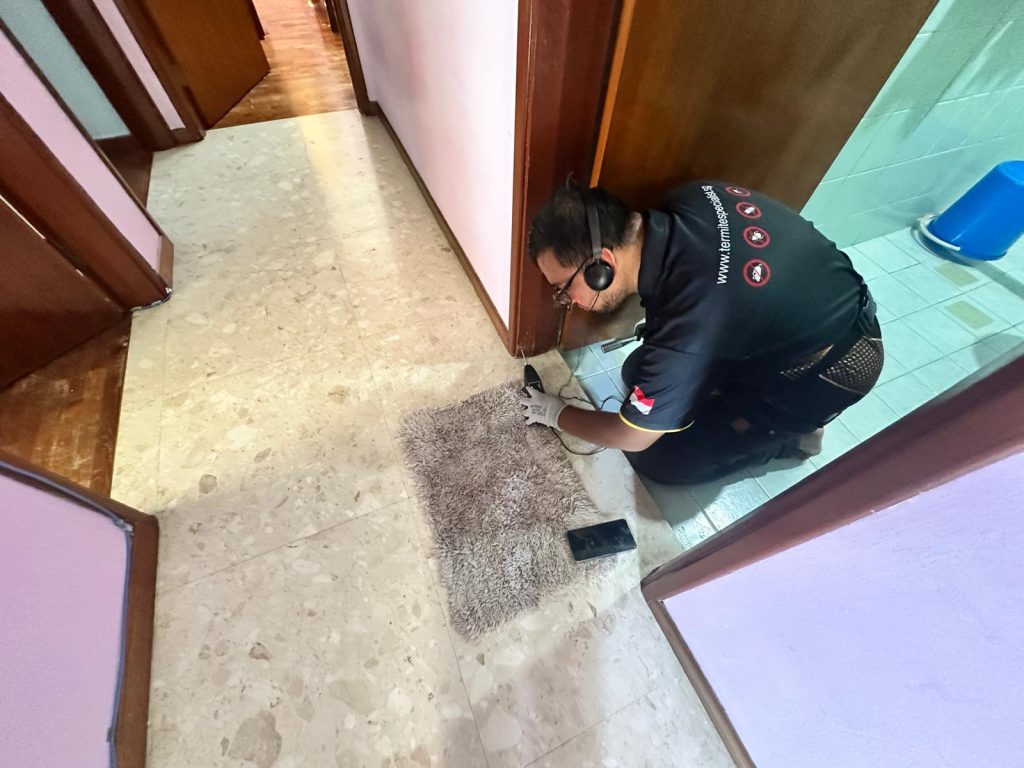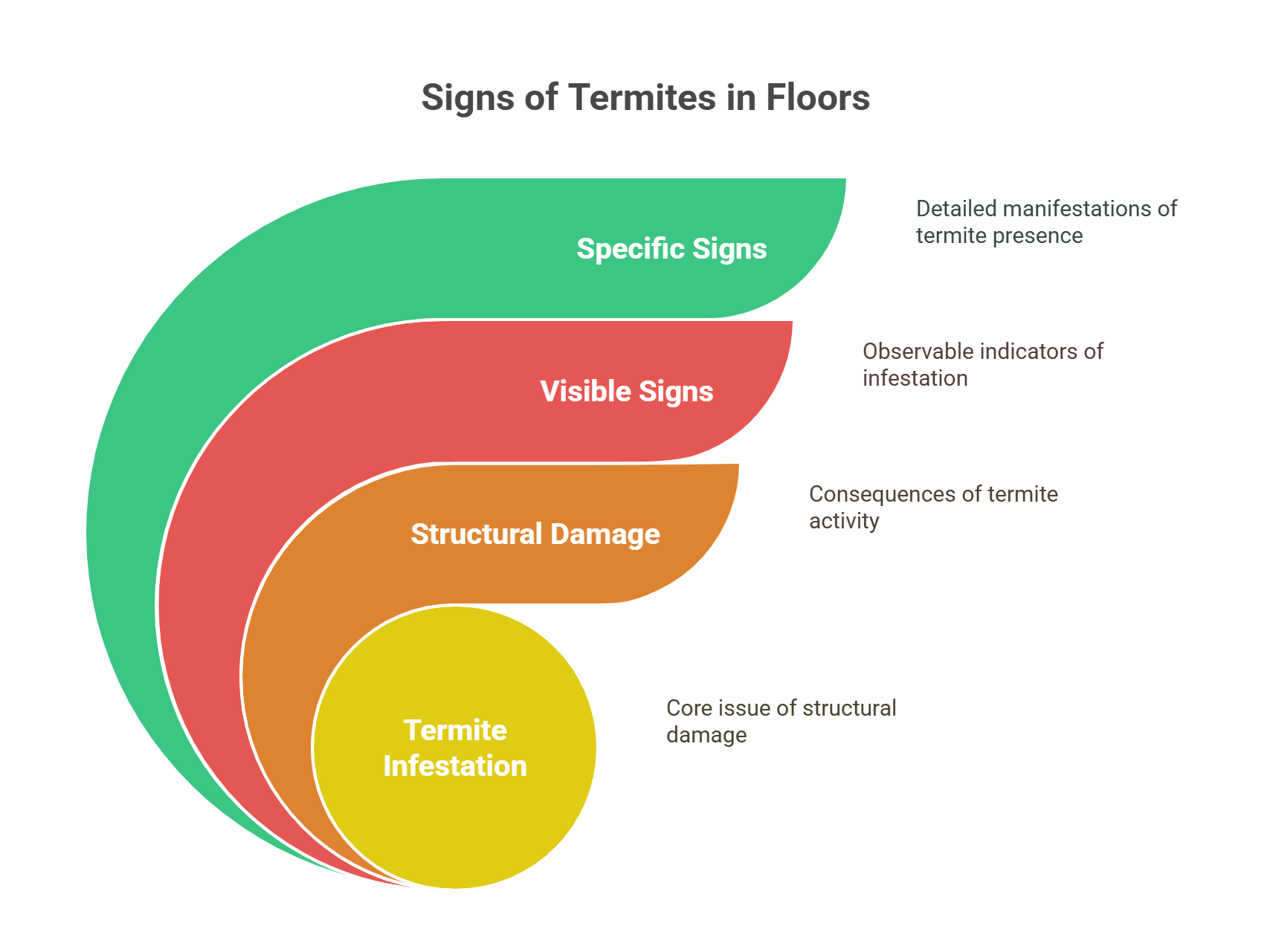The moisture environment and floor-to-soil contact attract termites in Singapore, causing damage to your commercial and business properties. You need to check the signs of termite infestations in the floor to take the necessary steps to eliminate them and keep your floor safe. Common signs of termite infestation in the floor include blistering floors, cracked tiles, hollow-sounding wood, buckling sections, and termite frass. Look for mud tubes, sagging boards, loosened floor tiles, exit holes, and squeaky surfaces as well.

10 Common Signs of termites in the floor

Blistering or Bubbling
One of the most common signs of termite infestation is blistering floors caused by subterranean termites. These destructive pests create networks of tunnels under your floor, trapping moisture and causing wood to bubble. You might think of this as water damage, but it actually occurs due to termite activity. Your floor joists degrade the wood structure.
Maze-Like Patterns or Tunnels Under Flooring
You will see maze-like tunnels after lifting the floorboards. This happens due to drywood termite activity. These termite galleries can be carved into subflooring, wooden furniture, and even wooden ceilings. The presence of such a pattern is a serious concern for your property structure.
Hollow-Sounding Wood When Tapped
The termite galleries burrow through the wood and create a space under the floor to create a hollow sound when tapped. Drywood and Formosan termites are responsible for such damage. You cannot see these damages early on, but these can compromise the load-bearing support beams and other structural integrity.
Buckling or Sagging Floor Sections
When the termite colonies eat through critical framing elements of your floor, it leads to buckling or sagging around support posts and floor joists. Moist environments are mostly responsible for such an attack.
Cracks in Floor Tiles or Wood Planks
Unexplained cracks in Floor Tiles or wood planks are a major sign of termite nests near foundation walls. This happens when termites weaken the underlying materials, resulting in instability and fractures to the tiles. It becomes prominent during termite season due to the higher presence of moisture.
Termite Droppings (Frass) Near Affected Areas
You will find sand or sawdust-like termite frass near cracks, floor seams, or corners. These droppings often come with other signs of termite damage, like blistering floors or pinholes.
Mud Tubes Along Floor Joints or Baseboards
Mud tubes are made by subterranean termites to reach food areas, travel from one place to another, and protect them from dry air and predators. You will find these tubes along floor joints, baseboards, or foundation walls. This sign indicates a nearby termite colony that requires immediate pest management or soil treatment.
Loosened or Detached Floorboards and Tiles
These wood-destroying pests weaken the substrates, leading to loose or detached floorboards and tiles. You may confuse it with aging floors, but this is a result of damaged structural integrity.
Uneven or Squeaky Flooring
Unexplained squeaky sounds and uneven surfaces may result from wood damage caused by live termites. It happens when termites eat wood and leave void spaces under the wood, leading to subtle shifting of the floorboard.
Tiny Exit Holes or Pinholes in the Floor
Flying termites or termite swarmers leave the place through small holes in the flooring or floor corners. These act as exit points for them during their mating cycle. It is a dangerous sign since termite mating means the colony is mature enough to expand. Lack of immediate action can cause significant damage.
What to do if you see these signs?
- Look for other signs and be sure there are termite infestations in the floor. Find the colony and tubes.
- Do not break or damage the colony or tubes, since it can scatter them and make the treatment harder.
- Take pictures of the damage on the floor to share them with pest control professionals.
- Contact a licensed professional to inspect and treat termites.
- Explore different treatment options such as borate treatment, soil treatment, and others.
- Repair damaged areas as soon as possible to avoid further damage to the floor.
- Ensure preventive measures.
How can termite infestation on the floor be prevented?
- Perform regular termite inspection at least once every three months.
- Maintain low humidity and moisture level using dehumidifiers and fixing leaks and pipes.
- Seal the cracks and leaks using chalk to block entry points.
- Chemical barriers should be applied to prevent termites from coming.
- Use treated wood while installing the floors to avoid infestations.
- Try to avoid wood-to-soil contact since termites love that contact.
- Consider prompt treatments once you see the early signs of termites.
If you still think that you need help? Termite Specialist offer effective termite treatment, including Baiting Treatment. corrective and soil treatment. Contact us today or visit our office. Get directions.
Read Our Recent Termite Blogs
13 Years of experience taught us a few things
